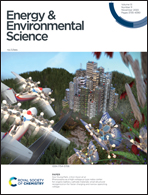Solar water splitting exceeding 10% efficiency via low-cost Sb2Se3 photocathodes coupled with semitransparent perovskite photovoltaics†
Abstract
Solar water splitting directly converts solar energy into H2 fuel that is suitable for storage and transport. To achieve a high solar-to-hydrogen (STH) conversion efficiency, elaborate strategies yielding a high photocurrent in a tandem configuration along with sufficient photovoltage should be developed. We demonstrated highly efficient solar water splitting devices based on emerging low-cost Sb2Se3 photocathodes coupled with semitransparent perovskite photovoltaics. A state-of-the-art Sb2Se3 photocathode exhibiting efficient long-wavelength photon harvesting enabled by judicious selection of junction layers was employed as a bottom absorber component. The top semitransparent photovoltaic cells, i.e., parallelized nanopillar perovskites using an anodized aluminum oxide scaffold, allowed the transmittance, photocurrent, and photovoltage to be precisely adjusted by changing the filling level of the perovskite layer in the scaffold. The optimum tandem device, in which similar current values were allocated to the top and bottom cells, achieved an STH conversion efficiency exceeding 10% by efficiently utilizing a broad range of photons at wavelength over 1000 nm.



 Please wait while we load your content...
Please wait while we load your content...